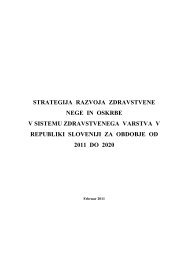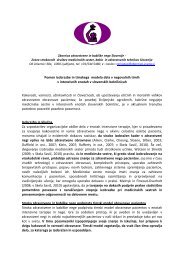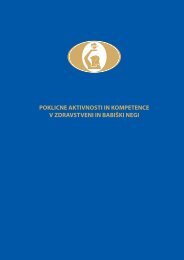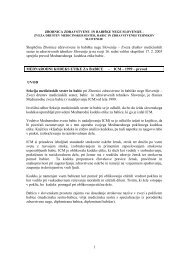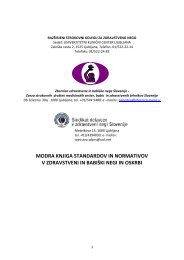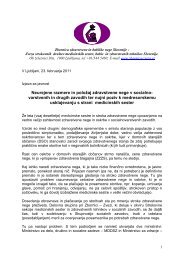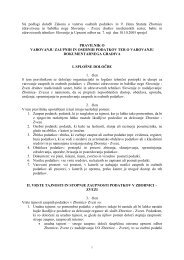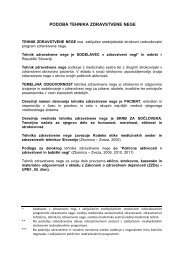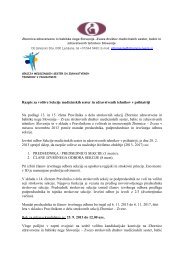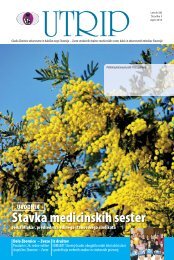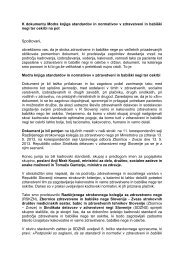P o sitio n S ta te m e n t - Zbornica - Zveza
P o sitio n S ta te m e n t - Zbornica - Zveza
P o sitio n S ta te m e n t - Zbornica - Zveza
You also want an ePaper? Increase the reach of your titles
YUMPU automatically turns print PDFs into web optimized ePapers that Google loves.
In<strong>te</strong>rnational<br />
Council of Nurses<br />
________________________________<br />
3, place Jean-Mar<strong>te</strong>au<br />
CH -1201 Geneva � Switzerland<br />
Telephone +41 (22) 908 0100<br />
Fax +41 (22) 908 0101<br />
e-Mail : icn@icn.ch<br />
Websi<strong>te</strong> : www.icn.ch<br />
ICN Po<strong>sitio</strong>n:<br />
The nursing profession worldwide recognises the vi<strong>ta</strong>l role the natural<br />
environment plays in global health and acknowledges the real threat posed by<br />
health care was<strong>te</strong>.<br />
The In<strong>te</strong>rnational Council of Nurses (ICN) believes all nurses have a duty to<br />
reduce/elimina<strong>te</strong> the negative impact of health care was<strong>te</strong> on individuals,<br />
communities and the environment. ICN and national nurses associations<br />
(NNAs), as represen<strong>ta</strong>tive organisations of nurses and nursing, have the<br />
responsibility to direct clinical and policy decisions with regard to health care<br />
was<strong>te</strong>.<br />
ICN supports initiatives to reduce the harmful impact of health care was<strong>te</strong>,<br />
including:<br />
• Purchase decisions that favour recycled paper and products, reduce the<br />
toxicity of products used and the volume of packaging ma<strong>te</strong>rials.<br />
• Use of the marketplace to develop al<strong>te</strong>rnative low-toxicity products, e.g.<br />
replacing chlorina<strong>te</strong>d plastics (PVC), la<strong>te</strong>x and mercury.<br />
• Limiting the use of pesticides.<br />
• Was<strong>te</strong> segregation with stra<strong>te</strong>gically placed recep<strong>ta</strong>cles to reduce the<br />
volume of was<strong>te</strong> requiring special at<strong>te</strong>ntion and facili<strong>ta</strong><strong>te</strong> the recycling of<br />
ma<strong>te</strong>rials whenever possible.<br />
• Was<strong>te</strong> treatment choices that minimize toxic disinfec<strong>ta</strong>nts and s<strong>te</strong>rilants.<br />
• Was<strong>te</strong> disposal choices that reduce harmful effects of incineration to the<br />
maximum ex<strong>te</strong>nt possible.<br />
• Patient, population and professional education on the impact of<br />
environmen<strong>ta</strong>l pollution.<br />
• Recycling ma<strong>te</strong>rials whenever possible and without compromising<br />
patient safety.<br />
Nurses, as professionals, need to be aware of the consequences of the health<br />
care was<strong>te</strong> produced by the health sector. Nursing organisations need to:<br />
• Define and regula<strong>te</strong> nursing compe<strong>te</strong>ncies in environmen<strong>ta</strong>l health.<br />
• Facili<strong>ta</strong><strong>te</strong> nurses’ access to continuing education programmes on the<br />
subject of health care was<strong>te</strong>.<br />
• Apply a precautionary approach to product evaluation and selection that<br />
pro<strong>te</strong>cts the environment.<br />
• Advoca<strong>te</strong> for the involvement of direct care nurses in decision-making.<br />
Po<strong>sitio</strong>n S<strong>ta</strong><strong>te</strong>ment Health care was<strong>te</strong>: role of nurses and nursing<br />
over/
Health care was<strong>te</strong>: role of nurses and nursing, page 2<br />
• Advoca<strong>te</strong> for recycling procedures and was<strong>te</strong> disposal mechanisms that<br />
do not compromise patient safety, including properly labelled con<strong>ta</strong>iners<br />
for was<strong>te</strong> segregation.<br />
• Strengthen the involvement of nurses in was<strong>te</strong>-rela<strong>te</strong>d policy formulation,<br />
incorpora<strong>te</strong> environmen<strong>ta</strong>lly-friendly and safe was<strong>te</strong> disposal models in<br />
nursing curricula and facili<strong>ta</strong><strong>te</strong> nurses’ access to continuing education<br />
programmes on the subject of health care was<strong>te</strong>.<br />
• Promo<strong>te</strong> the widespread introduction of safe needles, injection safety<br />
policies and the auto-disable syringe.<br />
• Encourage the reduction of excessive and unnecessary packaging.<br />
• Facili<strong>ta</strong><strong>te</strong> the es<strong>ta</strong>blishment of was<strong>te</strong> management regimes in all health<br />
institutions.<br />
• Support the introduction of incentives for health workers to incorpora<strong>te</strong><br />
environmen<strong>ta</strong>lly healthy practices in their professional in<strong>te</strong>rventions.<br />
• Develop coalitions with other professions to lobby for safe was<strong>te</strong><br />
disposal.<br />
• Lobby national governments to ratify UN Conventions on Healthy<br />
Environment.<br />
Background<br />
Health care treatment genera<strong>te</strong>s millions of tons of health care was<strong>te</strong> each year.<br />
This was<strong>te</strong> represents a serious risk to the environment if not properly managed<br />
and disposed.<br />
Health care was<strong>te</strong> “includes all the was<strong>te</strong>s genera<strong>te</strong>d by health care activities...<br />
activities of diagnosis as well as preventive, curative and palliative treatments in<br />
the field of human and ve<strong>te</strong>rinary medicine. In other words, all the was<strong>te</strong><br />
produced by a health care institution (public or priva<strong>te</strong>), a health care research<br />
facility or a laboratory” (SBC & WHO 2004 p. 8).<br />
The types of health care was<strong>te</strong> are numerous and have been classified as:<br />
• Infectious was<strong>te</strong><br />
• Pathological and anatomical<br />
• Hazardous pharmaceutical was<strong>te</strong><br />
• Hazardous chemical was<strong>te</strong><br />
• Was<strong>te</strong> with a high con<strong>te</strong>nt of heavy me<strong>ta</strong>ls<br />
• Pressurised con<strong>ta</strong>iners<br />
• Highly infectious was<strong>te</strong><br />
• Genotoxic/cytotoxic<br />
• Radioactive was<strong>te</strong><br />
Health care and its <strong>te</strong>chnology is a major contributor to the con<strong>ta</strong>mination of the<br />
world’s food, wa<strong>te</strong>r and air. Mishandled was<strong>te</strong> crea<strong>te</strong>d by treating one patient<br />
may cause others to get sick. Toxic and infectious was<strong>te</strong>s pose a serious threat<br />
to public health and the health of workers whose jobs expose them to their<br />
dangers.<br />
over/
Health care was<strong>te</strong>: role of nurses and nursing, page 3<br />
Primary health care, with its focus on the basic de<strong>te</strong>rminants of health,<br />
acknowledges the key role the environment plays on the health s<strong>ta</strong>tus of<br />
individuals, families and communities.<br />
A precautionary approach advoca<strong>te</strong>s for preventive measures to be <strong>ta</strong>ken to<br />
analyse and choose al<strong>te</strong>rnatives to po<strong>te</strong>ntially harmful products and activities.<br />
Clinical and policy decisions influence the production and disposal of health care<br />
was<strong>te</strong>. The procurement, use and disposal of health care supplies affect the<br />
volume, labour in<strong>te</strong>nsity and cost of the resulting health care was<strong>te</strong> disposal.<br />
Nurses in clinical care are producers of health care was<strong>te</strong> and are active<br />
participants in was<strong>te</strong> disposal procedures. Nurses in management po<strong>sitio</strong>ns<br />
develop policies that deal with the procurement of supplies as well as the<br />
production and elimination of health care was<strong>te</strong>. Educational institutions (nursing<br />
schools) also genera<strong>te</strong> large amounts of equipment was<strong>te</strong> which must be<br />
effectively managed, serving as role models for others.<br />
References:<br />
The Health Care Industry’s Impact on the Environment: Stra<strong>te</strong>gies for Global Change,<br />
American Nurses Association and The University of Vermont, 1998<br />
Institu<strong>te</strong> of Medicine Report: Nursing, Health and the Environment. National Academy<br />
Press, Washington DC,1995<br />
Health Care Management: Handbook for Nurses. In<strong>te</strong>rnational Council of Nurses, 2009<br />
Secre<strong>ta</strong>riat of the Basle Convention & World Health Organization (2004), Preparation of<br />
national health care was<strong>te</strong> management plans in sub-Saharan countries [guidance<br />
manual], accessed 17 July 2007,<br />
www.who.int/wa<strong>te</strong>r_sani<strong>ta</strong>tion_health/medicalwas<strong>te</strong>/en/guidancemanual.pdf<br />
Adop<strong>te</strong>d in 1998<br />
Reviewed and revised in 2004 and 2010<br />
Rela<strong>te</strong>d ICN Po<strong>sitio</strong>ns:<br />
• Universal access to clean wa<strong>te</strong>r<br />
• Nurses, clima<strong>te</strong> change and health<br />
• Occupational health and safety for<br />
nurses<br />
The In<strong>te</strong>rnational Council of Nurses is a federation of more than 130 national<br />
nurses associations representing the millions of nurses worldwide. Opera<strong>te</strong>d by<br />
nurses and leading nursing in<strong>te</strong>rnationally, ICN works to ensure quality nursing<br />
care for all and sound health policies globally.



